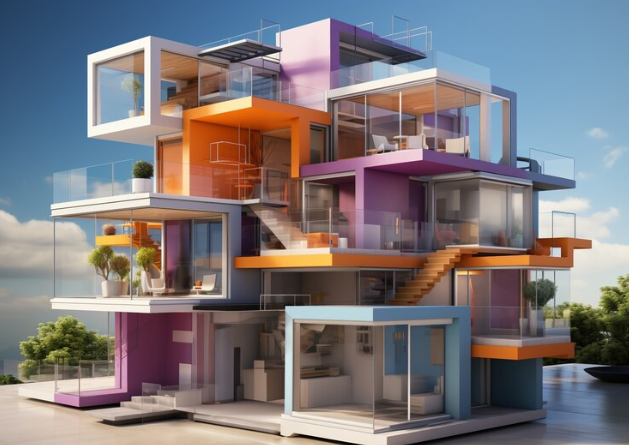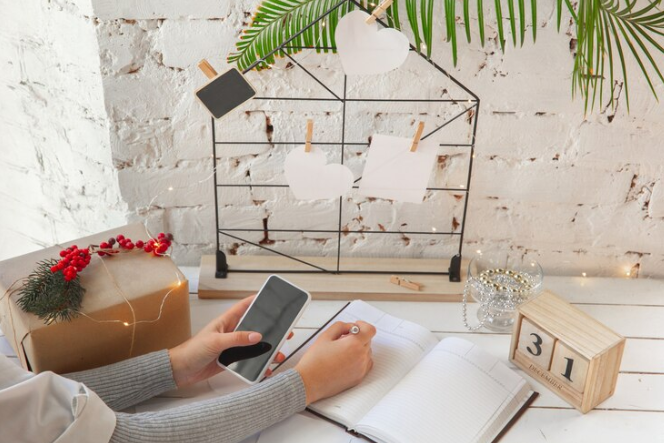Introduction:
Hey there, design enthusiasts! Ever step into a room and instantly feel its magic? That’s the power of good interior design. It’s more than just furniture and paint; it’s about transforming your living spaces into sanctuaries that reflect your personality and enhance your life. But where do you even begin, especially if you’re new to the world of design? Don’t worry, we’ve got your back! This guide will equip you with the essential knowledge and inspiration to embark on your interior design journey. So, grab your favorite mug, cozy up, and let’s dive in!
Subheadings:
1.Demystifying Interior Design: It’s More Than Just Decorating!

So, you’re interested in interior design? Great! But before you dive headfirst into Pinterest boards and fabric samples, let’s break down the basics. Interior design is much more than just picking out pretty pillows and arranging furniture. It’s about creating functional, beautiful, and healthy spaces that reflect your unique style and personality.
Think of it like this: interior design is the art of making your home work for you. It’s about understanding how you use space, what your needs are, and then using design principles to create a space that meets those needs. It’s about balancing form and function, aesthetics and comfort.
Of course, there’s still plenty of room for creativity! But with a solid understanding of the basics, you can make informed decisions about your space and create a home that you truly love.
Here are a few key things to keep in mind as you start your interior design journey:
- Space planning: This is all about understanding how you use your space and making the most of it. Think about traffic flow, furniture placement, and storage needs.
- Color and light: These elements can have a big impact on the mood and feel of your space. Use color strategically to create different moods and use light to highlight your favorite features.
- Furniture and finishes: These are the pieces that will make your space feel like home. Choose furniture that is both functional and stylish, and don’t forget about the details like finishes and hardware.
- Accessories: These are the finishing touches that will personalize your space and make it your own. Don’t be afraid to experiment and have fun!
With a little planning and creativity, you can create an interior design that is both stylish and functional. So go forth and start designing your dream home!
2.Ready to revamp your space but clueless about your style?

Figuring out your interior design style can feel overwhelming, but it doesn’t have to be! Here’s a fun and easy way to get started:
- Think about your favorite things. What kind of clothes do you gravitate towards? What are your favorite restaurants or cafes? What places do you find most inspiring? Pay attention to the colors, textures, and overall vibe that draws you in.
- Create a mood board. Gather images from magazines, Pinterest, or online sources that capture the look and feel you love. Don’t worry about specific items or trends right now – just focus on the overall aesthetic.
- Identify recurring themes. Once you have a collection of images, step back and see if any patterns emerge. Are you drawn to clean lines and minimalist spaces? Or maybe you love cozy, eclectic vibes?
- Refine your style. Now that you have a better understanding of your preferences, start exploring specific design styles that resonate with you. Look at examples of Scandinavian, mid-century modern, farmhouse, or any other style that piques your interest.
- Don’t be afraid to experiment! The best way to find your signature style is to have fun and try new things. Remember, there are no hard and fast rules in interior design – it’s all about creating a space that reflects your unique personality and makes you feel good.
3.Mastering the Art of Interior Design: Space Planning Like a Pro
Ever dream of transforming your living space into a magazine-worthy masterpiece? Well, fear not, aspiring design enthusiasts! The key to achieving a home that’s both beautiful and functional lies in the art of interior design. And at the heart of it all? Space planning!
Think of space planning as the invisible blueprint that brings your design dreams to life. It’s about understanding how people move and interact within a space, and then using furniture, finishes, and accents to create a layout that’s both aesthetically pleasing and perfectly suited to your needs.
Here are some key tips to help you space plan like a pro:
- Measure everything!: Before you start rearranging furniture, grab a tape measure and map out your space. Understanding the dimensions of your room is crucial for making informed decisions about furniture placement and traffic flow.
- Define your zones: Imagine your home as a collection of mini-environments, each serving a specific purpose. Whether it’s a cozy reading nook, a bustling kitchen, or a serene bedroom, define the different zones in your space and arrange furniture accordingly.
- Consider scale and proportion: Furniture that’s too small or too large can throw off the balance of your room. Choose pieces that are appropriately sized for the space and create a sense of visual harmony.
- Let there be light!: Natural light is a game-changer in interior design. Maximize natural light by positioning furniture away from windows and using sheer curtains instead of heavy drapes. And don’t forget about artificial lighting! Layering different light sources can create ambiance and highlight specific areas of your space.
- Accessorize with intention: The right accessories can add personality and polish to your space. But avoid clutter! Choose a few statement pieces that complement your overall design scheme.
By following these simple tips and unleashing your creativity, you can transform your living space into a haven of functionality and style. Remember, space planning is all about experimentation and having fun! So grab your tape measure, let your imagination run wild, and start creating your dream home today!
4.Interior design magic
conjures up images of vibrant spaces that transform the way you feel and live. It’s more than just paint colors and furniture placement; it’s about weaving together your personality, lifestyle, and dreams to create a home that’s uniquely yours.
Imagine stepping into a kitchen bursting with sunshine yellow walls, where every meal feels like a celebration. Or picture a cozy living room bathed in the warm glow of terracotta tones, perfect for unwinding after a long day. With the right interior design magic, your home can be a sanctuary that reflects your true self.
So, are you ready to unlock the potential of your space? Let’s embark on a journey to create an interior that ignites your soul and makes you say, “This is magic!”
5.The Building Blocks of Beautiful Homes: Interior Design Fundamentals

Imagine walking into a space that feels instantly inviting, where every piece of furniture complements the others and contributes to a cohesive atmosphere. That’s the magic of understanding interior design fundamentals! Just like baking a delicious cake requires mastering the basics, creating a stunning interior starts with a solid grasp of the building blocks.
Think of furniture as the actors in your design play. Each piece has a role to play, from the ever-so-important sofa that anchors the living room to the whimsical accent chair that injects personality. Understanding scale and proportion ensures your furniture doesn’t overwhelm the space or get dwarfed by it. Consider the room’s dimensions and traffic flow to create a layout that’s both functional and aesthetically pleasing.
But furniture isn’t just about looks. It’s about comfort, too! Choose pieces that cater to your lifestyle and needs. Invest in a supportive mattress for restful sleep, and select chairs that offer good back support for long chats with loved ones. Remember, furniture should be enjoyed, not just admired.
And then there’s the magic of materials and textures. Wood, metal, fabric, leather – each element brings its own unique character to a space. Mixing and matching textures adds depth and visual interest, while keeping a consistent color palette ties everything together. Don’t be afraid to experiment and find combinations that resonate with you!
By mastering these interior design fundamentals, you’ll be well on your way to creating a home that reflects your style and personality. Remember, it’s a journey, not a destination, so have fun exploring and expressing yourself through the power of furniture!
6. Sustainability in Style
Who says looking good can’t be good for the planet? Sustainable interior design is all about creating a stylish and comfortable home that’s also kind to the environment. By using recycled materials, energy-efficient appliances, and eco-friendly finishes, you can create a space that you’ll love without sacrificing your values.
Here are a few tips for getting started with sustainable interior design:
- Shop secondhand: There are amazing treasures to be found at thrift stores, antique shops, and online marketplaces. You’ll save money and give pre-loved furniture a new lease on life.
- Choose natural materials: Opt for furniture made from wood, bamboo, or cork instead of synthetic materials. Natural materials are often more durable and can be recycled or composted at the end of their useful life.
- Invest in energy-efficient appliances: Look for Energy Star-certified appliances that use less energy and water.
- Use LED lighting: LED bulbs are much more energy-efficient than traditional incandescent bulbs and last much longer.
- Let in natural light: Open up your curtains and blinds to let in natural light, which can help reduce your reliance on artificial lighting.
- Add plants: Plants not only look great, but they also help to improve air quality.
With a little creativity, you can easily create a sustainable and stylish home that you’ll be proud of.
7. DIY or Pro: Interior Design Edition

So, you’re itching to spruce up your home and transform it into a stylish haven, but the question remains: DIY or pro? When it comes to interior design, there’s no one-size-fits-all answer. It really boils down to your comfort level, budget, and the scope of your project.
The DIY approach is all about unleashing your creativity and putting your personal touch on things. It can be a rewarding and cost-effective way to go, especially for smaller projects like painting an accent wall, revamping furniture, or crafting decorative accents. Plus, there’s a certain satisfaction that comes from saying, “I did that myself!”
However, DIYing also comes with its fair share of challenges. If you’re not handy or design-savvy, it can be easy to make mistakes that end up costing you more time and money in the long run. And let’s not forget the potential for frustration and stress!
Hiring a professional interior designer can be a great option if you’re looking for a polished, seamless, and stress-free outcome. Pros have the expertise, resources, and connections to bring your vision to life, no matter how grand or complex. They can help you with everything from space planning and furniture selection to color palettes and lighting design.
Of course, hiring a pro comes with a higher price tag. But if you consider the value of their expertise, time saved, and potential cost savings from avoiding costly mistakes, it might be worth the investment.
Ultimately, the decision of DIY vs. pro depends on your individual needs and circumstances. Weigh the pros and cons carefully, and don’t be afraid to get creative!
8. Interior Design Inspiration at Your Fingertips!
Feeling stuck in a design rut? Don’t worry, we’ve all been there. But fear not, because interior design inspiration is closer than you think! In fact, it’s right at your fingertips with the help of the internet. With a few clicks, you can browse through countless websites, blogs, and social media accounts filled with stunning photos and creative ideas. Whether you’re looking for a complete home makeover or just a few simple tweaks, there’s something out there to inspire you.
So next time you’re feeling uninspired, ditch the paint chips and fabric swatches and head online. With a little exploration, you’re sure to find the perfect spark to ignite your creativity and help you create a home that you love.
Conversational Style Tips:
- Use contractions and emojis sparingly (e.g., “don’t” instead of “do not,” instead of “happy face”).
- Ask rhetorical questions to engage the reader.
- Inject humor and personal anecdotes where appropriate.
- Avoid overly technical jargon, explain terms simply.
- Maintain a friendly and approachable tone throughout.
Remember:
- Use relevant keywords throughout the article for SEO optimization.
- Break up the text with images, infographics, or videos to enhance visual appeal.
- Include internal links to related articles on your website.
- Encourage reader engagement with calls to action (e.g., “share your design ideas in the comments!”).

